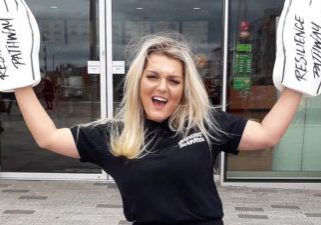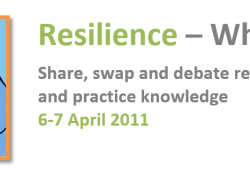Boingboing blogs from… the Resilience Forum!
Birthing in our community: A partnership approach to ‘closing the gap’ in health outcomes, and building resilience, for Aboriginal and Torres Islander mothers and babies in an Australian setting – Prof Sue Kildea, Midwifery Research Unit, Mater Health Service and University of Queensland, Brighton Resilience Forum – Friday 8 April 2016
by Angie, Boingboing volunteer and blogger
Hiya folks, Angie on blog duty this week. Prof Sue Kildea’s up this week (she arrived a week early, but we still managed to drum up a dozen or so people to hear her talk – I’m thrilled, given how fascinating her work is that’s fab). Sue’s from the University of Queensland in Oz and she’s raised millions of quid in funding for excellent co-productive work. Of course I want to be her bezzie mate so we can do some projects together and she can help us bring in the cash, but I’m also totally fascinated to hear what she’s been up to lately. She’s doing her talk on Indigenous birthing in an urban setting. Sue’s been working in this area for years now, though often out in the most remote parts of Australia. Working side by side with Indigenous Australians, she’s learnt loads about Aboriginal health and culture. I’m so excited that she’s here.
Sue shows us a map of Oz and says she’s been working mostly in remote parts of Australia – Aboriginal communities are geographically very diverse, spread out across the country. Government documents assert that Australia is one of the safest countries in the world to give birth or be born. Yet, as Sue says, there are huge differences in outcomes between white babies and Indigenous babies. And overall, Indigenous Australians have worse health outcomes than Indigenous people in many other countries like New Zealand, Canada and America. Makes me wonder what resilient moves are happening in those countries, where the stats are bad, but they aren’t as bad as in Oz. Later on Sue provides a few answers specifically in relation to supporting mums and bubs, as she puts it, to have better outcomes.
The major resilient moves here are privileging Indigenous control over what is happening, respect for Indigenous knowledge, and incorporation of traditional practice, something Sue has only learned through her direct work with Indigenous communities. Culturally competent services and staff are important as well as good outreach work with women and their families. The list goes on. Apparently they have cracked it now in Canada. They have much better Indigenous birthing practices that are really respectful of local knowledge.
Talking of resilience, now Sue’s not quite sure how her talk relates to resilience, but she put it in the title. She tells everyone I made her put it in the title, and that she doesn’t know anything about it. I’m going to help her out now and make a few connections. Ok, let’s take our definition of resilience, the beating the odds and changing the odds perspective that we Boingboingers keep banging on about:
‘Resilience is overcoming adversity, whilst also potentially subtly altering, or even dramatically transforming, (aspects of) that adversity.’
Well, first off, her statistics suggest that being resilient to early death is a key thing to aim for in Oz for Indigenous Australians. Aboriginal men and women die around 17 years earlier than non-Aboriginal men and women. Supporting a child to become resilient to dying in their early years, or a mum to survive childbirth, are serious issues that she is grappling with. There are complex intersecting social determinants of health, including endemic racism in institutions and reduced access to societal resources. Thinking of our resilience definition, this would certainly involve practices that would end up overcoming, and also dramatically transforming (aspects of), adversity.
Some of the statistics she tells us about are making people in the room get in a right tizz. Did you know that 80 million dollars are spent on the surveillance and removal of Indigenous kids in Oz, whereas just half a million dollars are spent on supporting parents to look after those children in the first place? Can you believe that? Shocking statistics with an extensive history.
Well, Sue and her team are doing their bit to try to change some of these shocking outcomes. Her work on Birthing in Our Community is a partnership between different organisations. They provide an enhanced midwifery service offering 24/7 care. However, it has a lot of challenges. Sue found that the midwives who did the home visiting were running around a lot and couldn’t take the same caseload as the other teams. They seemed to be spending more of their time addressing the social determinants of health, which are so important in this context and will also help to build longer-term resilience.
However, there are some good things happening. They are working in partnership with local Indigenous organisations and through the partnership they have an Indigenous psychiatrist and psychologists involved in offering clinical and cultural supervision to the midwives and others in the team. I’m pleased about this coz there is such a strong evidence base about the worth of clinical supervision in supporting practitioner resilience. Sue was thinking about cutting down the supervision to once a month, but I suggested it was good to have it more often. I hope her team are grateful to me for that. Also through the partnership and other funding they are now employing more Indigenous women to work side by side with the midwives. This includes a team co-ordinator, Family Support and Aboriginal Health Workers. They are also tapping into cultural support through a monthly Deadly Family Yarning Circle session.
Wrapped around the service is a research project that is looking to tackle social determinants and influence education, employment and training policy. We had a good discussion about whether it is research or political activism:
‘The kinds of things we need to make happen (e.g. events, parenting strategies, relationships, resources) to help children manage life when it’s tough. Plus ways of thinking and acting that we need ourselves if we want to make things better for children.’ (Aumann & Hart, 2009, p. 11)
Looking at the first 2 years the stats are very encouraging – Loads of people are actually coming along to the enhanced service, with for example women signing up for some of the specific services, like family yarning and smoking cessation.
Sue’s quite excited about her study I can tell. She’s tried to get as many Indigenous researchers and community partners on it. It was a specific strategy to do this. Over half of the people involved are Indigenous, including senior leaders. There are huge challenges, including the employment of Indigenous people to be part of the basic service and research team. She’s expanded her social circle. Welcome to our world Sue, it’s great to have you!


